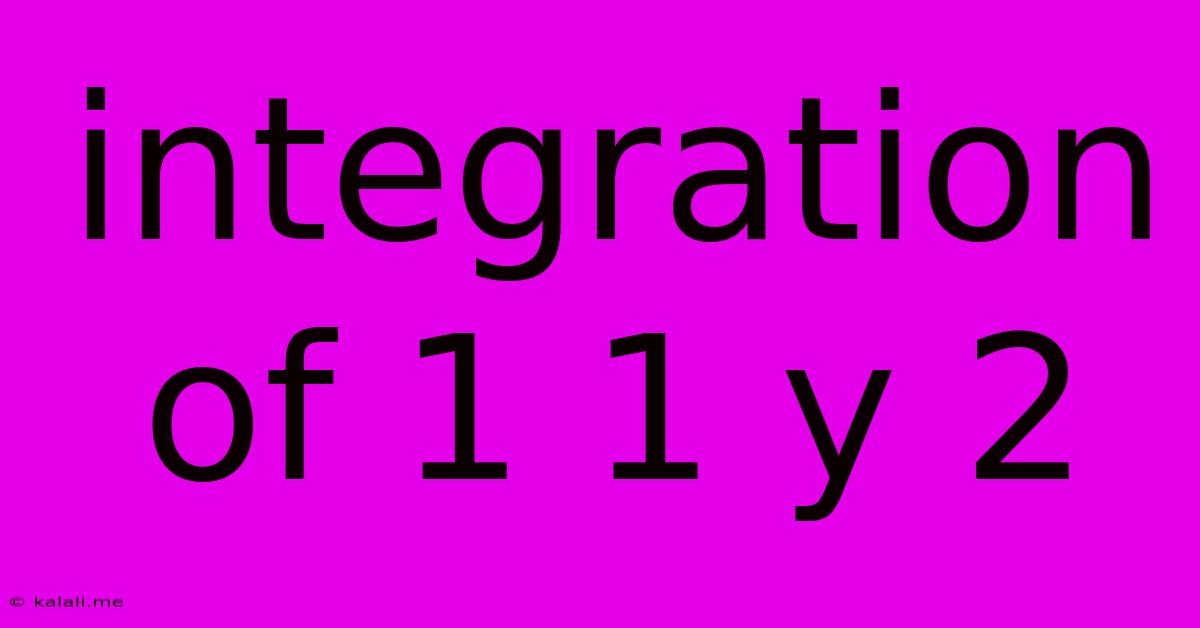Integration Of 1 1 Y 2
Kalali
May 24, 2025 · 3 min read

Table of Contents
The Seamless Integration of 1:1 and 1:Many Learning: A Powerful Hybrid Approach
Meta Description: Discover the power of blending 1:1 and 1:many learning models. This article explores the benefits, challenges, and practical strategies for successful integration, maximizing student outcomes.
The modern learning landscape demands flexibility and personalization. While traditional classroom settings (1:many) offer efficiency in delivering content to large groups, the individual needs of learners often get overlooked. Conversely, 1:1 learning, with its personalized attention, can be incredibly effective but often lacks the collaborative benefits of group learning. The key to unlocking truly impactful learning experiences lies in the seamless integration of 1:1 and 1:many approaches. This hybrid model leverages the strengths of both, creating a rich and dynamic learning environment.
Understanding the Two Models
Before diving into integration, let's define each approach:
-
1:1 Learning: This model focuses on individualized instruction, often utilizing technology like tablets or laptops. It allows for personalized pacing, targeted support, and immediate feedback. Students work at their own speed and receive tailored instruction based on their strengths and weaknesses. This can lead to significant improvements in learning outcomes, particularly for students who struggle in traditional classroom settings.
-
1:Many Learning (Traditional Classroom): This traditional model involves one instructor teaching a group of students. It provides opportunities for collaborative learning, peer interaction, and cost-effectiveness. However, it can be challenging to cater to diverse learning styles and paces within a single group.
The Power of Integration: A Synergistic Approach
Successfully integrating 1:1 and 1:many learning isn't simply about alternating between the two. It's about creating a synergistic environment where the strengths of each model complement and enhance the other. This requires careful planning, appropriate technology, and a commitment to differentiated instruction.
Benefits of a Hybrid Approach:
- Personalized Learning at Scale: 1:1 technology allows for personalized learning paths, while the 1:many model provides opportunities for group activities and discussions, making personalized learning scalable and efficient.
- Increased Engagement and Motivation: The flexibility and individualized attention of 1:1 learning can significantly boost student engagement, while collaborative projects in the 1:many setting foster teamwork and communication skills.
- Improved Learning Outcomes: Studies show that blended learning approaches, which effectively integrate 1:1 and 1:many models, can lead to demonstrably better academic performance and improved knowledge retention.
- Enhanced Teacher Effectiveness: Teachers can use 1:1 technology to monitor student progress in real-time, providing immediate feedback and adjusting their instruction accordingly. This personalized approach enhances teacher effectiveness and allows for more targeted support.
- Bridging the Learning Gap: 1:1 learning can be particularly beneficial for students who require additional support, bridging learning gaps and ensuring that all students can access high-quality education.
Challenges and Considerations
Integrating these two models is not without its challenges:
- Technology Infrastructure: Sufficient technology, reliable internet access, and adequate teacher training are crucial for successful implementation.
- Teacher Training and Professional Development: Educators need appropriate training to effectively utilize technology and implement differentiated instruction.
- Curriculum Design: The curriculum needs to be flexible enough to accommodate both individual and group learning activities.
- Cost: Implementing 1:1 learning can be expensive, requiring significant investment in technology and resources.
Practical Strategies for Successful Integration
- Flipped Classroom Model: Use 1:1 technology for pre-class assignments and independent learning, freeing up class time for collaborative activities and teacher-led discussions.
- Differentiated Instruction: Design lessons that cater to diverse learning styles and paces, using 1:1 technology to provide individualized support where needed.
- Collaborative Projects: Incorporate group projects that leverage the strengths of both models, allowing students to collaborate while still receiving personalized feedback.
- Regular Assessment and Monitoring: Use technology to track student progress and adjust instruction accordingly, ensuring that all students are making adequate progress.
The integration of 1:1 and 1:many learning approaches represents a significant shift in how we approach education. By thoughtfully combining the benefits of personalized learning with the efficiency and collaborative aspects of traditional classrooms, we can create truly dynamic and effective learning experiences for all students. The key is careful planning, adequate resources, and a commitment to fostering a flexible and supportive learning environment.
Latest Posts
Latest Posts
-
In Or On The Other Hand
May 25, 2025
-
If She Smokes She Pokes Meaning
May 25, 2025
-
Inverse Cdf Of Continuous Variable Is Continuous
May 25, 2025
-
Ssh No Matching Key Exchange Method Found
May 25, 2025
-
How To Get The Pokeflute In Pokemon Fire Red
May 25, 2025
Related Post
Thank you for visiting our website which covers about Integration Of 1 1 Y 2 . We hope the information provided has been useful to you. Feel free to contact us if you have any questions or need further assistance. See you next time and don't miss to bookmark.